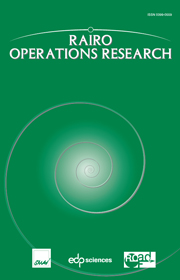Article contents
France Telecom workforce scheduling problem: a challenge
Published online by Cambridge University Press: 08 October 2009
Abstract
In this paper, we describe the methodology used to tackle FranceTelecom workforce scheduling problem (the subject of the RoadefChallenge 2007) and we report the results obtained on the different data sets provided for the competition. Since the problem at hand appears to be NP-hard and due to the highdimensions of the instance sets, we use a two-step heuristical approach. Wefirst devise a problem-tailored heuristic that provides good feasiblesolutions and then we use a meta-heuristic scheme to improve the currentresults. The tailored heuristic makes use of sophisticated integer programming modelsand the corresponding sub-problems are solved using CPLEXwhile the meta-heuristic framework is a randomized local search algorithm. The approach herein described allowed us to rank 5th in this challenge.
Information
- Type
- Research Article
- Information
- Copyright
- © EDP Sciences, ROADEF, SMAI, 2009
References
- 2
- Cited by

